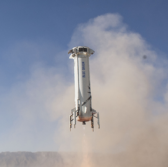 Five NASA-supported payloads lifted off Wednesday aboard Blue Origin’s New Shepard rocket from the company’s launch site in West Texas as part of a suborbital flight demonstration that aims to gather data and test the platforms in space.
Five NASA-supported payloads lifted off Wednesday aboard Blue Origin’s New Shepard rocket from the company’s launch site in West Texas as part of a suborbital flight demonstration that aims to gather data and test the platforms in space.
NASA said Thursday it selected the payloads through the Flight Opportunities program that supports flight testing of technologies on suborbital vehicles.
Some of those payloads include the Suborbital Flight Experiment Monitor-2 from NASA’s Johnson Space Center; Vibration Isolation Platform from Controlled Dynamics; and a communications technology tool from Solstar.
SFEM-2 is a package of sensors designed to measure pressure, temperature, acceleration, carbon dioxide, acoustic levels and humidity in a spacecraft, while Controlled Dynamics’ platform works to isolate payloads from flight disturbances.
The flight demonstration also included an experimental predictive platform from Purdue University and a Johns Hopkins University Applied Physics Laboratory-built system designed to collect electromagnetic field measurements.
The agency’s space technology mission directorate funds the Flight Opportunities program that has helped evaluate and further develop 136 technology payloads through 162 suborbital demonstrations.




